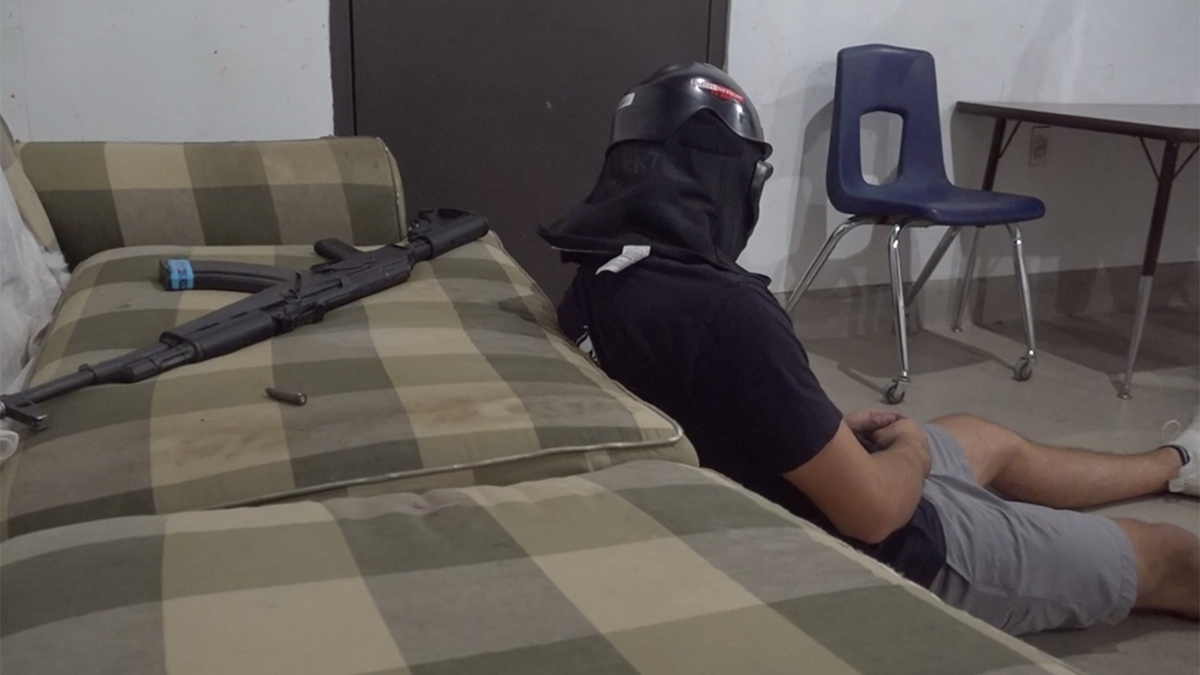Active shooter simulations are increasingly common within police department training
Fox News observed an active shooter simulation at the ALERRT Center in Maxwell, Texas, to get a better understanding of the training law enforcement goes through for these types of scenarios.
MAXWELL, TEXAS – Newtown, Connecticut; Parkland, Florida; and most recently Uvalde, Texas.
Those cities may ring a bell, as they’ve made headlines for deadly mass school shootings in the last decade.
Survivors of the Uvalde school shooting went back to school last week, so Fox News wanted to get a better understanding of the training law enforcement goes through for these types of scenarios.
Multimedia reporter Ashley Soriano experienced an active school shooter simulation at Texas State University’s Advanced Law Enforcement Rapid Response (ALERRT) Center.
TEXAS GOV. ABBOTT SAYS RAISING AGE TO BUY ASSAULT-STYLE RIFLE 'UNCONSTITUTIONAL'

Active shooter simulations are increasingly common within police department training. The ALERRT Center in Maxwell, Texas, has trained more than 240,000 first responders. (Fox News/Ashley Soriano)
It was created in 2002 to use research-based training in active shooter scenarios, including schools.
Every police department within 100 miles of the Maxwell, Texas, facility has come to train at the facility at some point.
They use equipment including mock ammunition and inert guns, radios, ear protectors, tourniquets and more.
"Our primary objective is to get [the shooter] secured as best we can, get the weapon away from him," said Sam Stock, the center’s Texas regional manager.
First responders learn how to prioritize what’s important first, second and so on.
"The first thing you need to do is to stop the killing," executive director Dr. Pete Blair said. "That's if you're hearing gunfire, you can see that people are being attacked. It's moving to stop that attacker as quickly as possible so they don't create any more casualties."
MEMPHIS LIVESTREAM MASSACRE CAUGHT ON SURVEILLANCE VIDEO AS SUSPECT EZEKIEL KELLY APPEARS IN COURT
He says the 1999 Columbine, Colorado, school shooting prompted a need for this sort of specialized training.
The center teaches first responders how to breach a locked or difficult-to-enter building, handle firearms, take down a gunman in a safe but quick manner, treat injuries and more.

Fox News observed an active shooter simulation at the ALERRT Center in Maxwell, Texas, in late August. Responding officers are taught to take down the gunman quickly. (Fox News/Ashley Soriano)
"If you look at extremely violent events like an active shooter event, most police officers would go through their entire career and never shoot at anybody," Dr. Blair said. "You need to have specialized training in it if you're going to respond successfully when an event happens."
Another big push in expanding training came after the 2012 Sandy Hook school shooting in Newtown, Connecticut.
"If we get it as close to the real thing as possible, then when you encounter the real thing, it’s less novel, it’s less different and it’s less shocking to your body, your system and your brain, so you’re able to perform better," Dr. Blair said.
The center expanded its training to include fire and EMS first responders. Since its founding, it has trained more than 248,000 personnel in all 50 states.
In addition, about 900,000 civilians have trained under the center’s Civilian Response to Active Shooter Events (CRASE) Avoid-Deny-Defend awareness program.
Police departments nationwide have ramped up their training, with simulations happening this summer in places including Fort Smith, Arkansas; Atlanta, Georgia and its surrounding metro cities; and Georgetown Kentucky, to name a few.
UVALDE SHOOTING REPORT REVEALS ‘MULTIPLE SYSTEMIC FAILURES’
Some police departments have started to train school staff members, such as in Fort Worth, Texas.

Local police departments have Ramped up its active shooter training efforts in the wake of recent mass school shootings. (Fox News/Ashley Soriano)
The Fort Worth Police Department confirmed to Fox News that it has provided training at no cost to more than 500 teachers across north Texas and continues to partner with local school Districts.
In Las Vegas, the Metro Police Department confirmed its Multi-Assault Counter-Terrorism Action Capabilities section has received training at the ALERRT Center at one point.
LVMPD told Fox News it routinely consults outside training agencies to "ensure our curriculum is consistent with best practices," although they do not instruct ALERRT specifically.
In March 2013, the FBI announced the ALERRT Center is the national standard and are training all their agents, according to the center’s website. Some major cities such as New York City, Miami, Houston, Dallas and Atlanta, are training their first responders in ALERRT tactics and standards.
The center’s campus has various stations, including a shooting range, staged simulation sets like classrooms and apartments and various types of doors to practice breaching.
UVALDE GANG RELATED SHOOTING LEAVES 2 JUVENILES WOUNDED AT PARK, POLICE SAY
The doors are specific to each type of breaching and which tools are needed: pry bars, rams, shotguns or explosives.
"Rule number one of breaching is always try the handle. You’ll be surprised how often people don’t, and you realize, ‘Oh, it was never locked,’" Dr. Blair said.

The ALERRT Center conducted its own investigation into the Uvalde mass shooting, finding multiple inconsistencies with its teaching of "stop the killing and stop the dying." (Fox News/Ashley Soriano)
Nearly 400 officers from different agencies responded to the Uvalde mass shooting, but it took over an hour to take down the gunman.
The ALERRT center released its own investigation into the police response, finding mistakes inconsistent with their teaching of "stop the killing and stop the dying."
According to the July 6 report, ALERRT staff performed a "pry" breach in a series of tests at Robb Elementary School during its investigation.
It took three to four seconds to pry open the door using a Stanley Fatt Maxx and a sledgehammer, although the report recognized in a real active shooter event, it would be dangerous for officers to do so without a ballistic shield.
CLICK HERE TO GET THE FOX NEWS APP
The report also suggested other breaching methods, such as using a 12-gauge shotgun.
Best practices in law enforcement are constantly changing, Dr. Blair said, and unfortunately "We're thinking we're going to see more of these events as time goes forward."





















